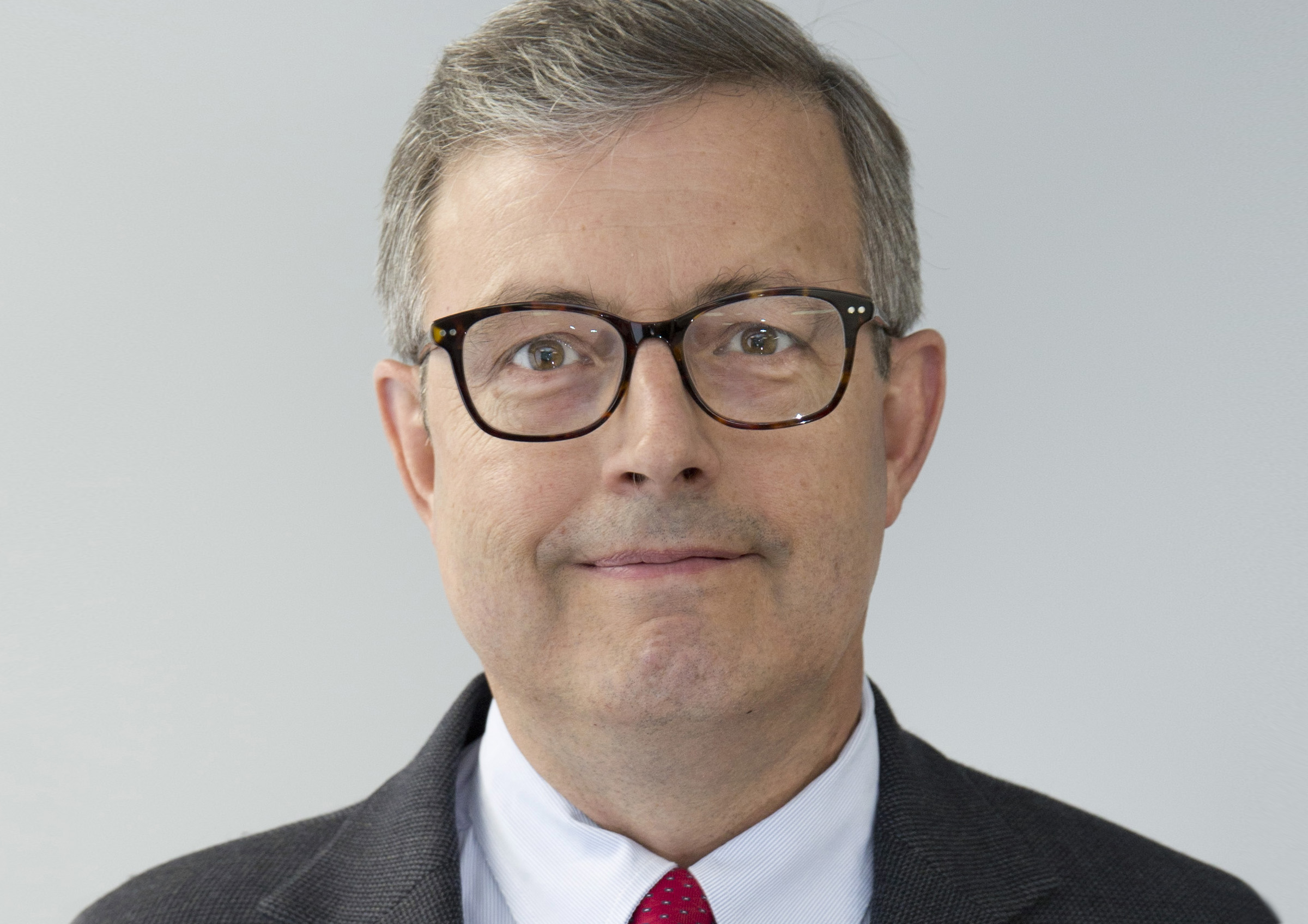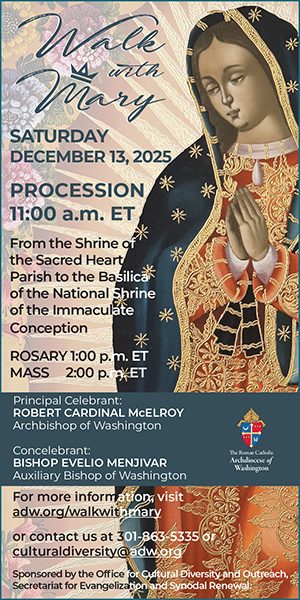On a day when the world saw the heart-rending images of Russia launching a brutal invasion of Ukraine, people gathered at the Ukrainian Catholic National Shrine of the Holy Family in Washington, D.C., on Feb. 24, 2022 to stand in solidarity, and kneel in prayer, for that embattled country and its people.
Father Peter Galadza, a Ukrainian Catholic priest, led the prayer service, and noted the great hope that the people of Ukraine felt after gaining independence in 1991 and having that freedom for more than three decades, after their people in the past century had experienced the “scars of intergenerational trauma” of numerous occupations and regime changes.
That, he said, “makes this present moment so much more painful.”
“We just did not imagine everything we read about in the history books, everything our parents told us about their experiences, every tear they had shed… We thought that was over, a thing of the past. Yet today it’s being revisited upon us again,” the priest said.
Then Father Galadza began to cry slightly, and he continued, “So what do we do? We do what our parents have done for centuries. We come to Mary.”


That evening prayer service, held as a cold, misty rain fell outside, was called a “Moleben to the Mother of God,” an intercessory prayer service that Eastern churches hold, and on this night, they sought the help of Mary, who among her titles is venerated by Catholics as the Queen of Peace. An icon of the Holy Family, with Mary, Joseph and the child Jesus, was placed in front of the sanctuary, flanked by flickering candles.

Earlier, the priest thanked the people there who had joined the prayer service. The crowd of about 60 people included Ukrainian Catholics who attend Divine Liturgies at that shrine, families with young children, students from the neighboring Catholic University of America, senior citizens, and people of other faiths.
“I can’t tell you what a consolation it is to have people from the broader community (here). You don’t know what it means. Knowing somebody cares makes all the difference in the world,” the priest said.

Father Galadza, a Canadian priest who is a visiting professor teaching liturgy at Catholic University, encouraged people to do whatever they can to support Ukraine and its citizens, such as mobilizing prayer vigils, joining protests and providing humanitarian aid.
The prayer service, offered in Ukrainian and English, was all sung in chants, that at times seemed sorrowful and in other times seemed hopeful.
The priest prayed that God would help the people of Ukraine find the strength and wisdom to bear this cross and also to experience the hope of the resurrected Christ.
“The Lord who has risen from the dead, that Lord wants to give us strength, wisdom and fortitude to do God’s will,” Father Galadza said. “…It’s our task today to do whatever we can to carry the name of Jesus the risen Lord in our hearts.”
Earlier that afternoon, Washington Cardinal Wilton Gregory had issued a tweet saying, “We turn to the Mother of God, Our Lady Queen of Peace, & ask her to protect the people of Ukraine & strengthen people who continue to seek & pursue a diplomatic halt to this latest tragedy of war.”
The cardinal also echoed Pope Francis’s recent call to mark Ash Wednesday on March 2 as a day of prayer and fasting for peace in Ukraine.

Throughout that day, people had come to pray at the Ukrainian Catholic National Shrine of the Holy Family.
Before the prayer service, Emma Jensen, a Catholic University politics major from Texas, came to the shrine to pray after seeing the images of the invasion of Ukraine on television.
“I think you just want to do something… I thought I could place roses in front of Mary, and she could help out,” said Jensen, who noted she is seeking a degree in peace and mediation.

Those attending the prayer service included three Episcopal seminarians from the Virginia Theological Seminary in Alexandria.
“We wanted to show Christian unity. We wanted to show our solidarity and support for Ukraine… and ask Mary the Mother of God for her protection at this time for Ukraine,” said seminarian Theodore Somes.
Fellow Episcopal seminarian Keith Esposito served as a Peace Corps volunteer from 2011-13 in Ukraine, working as a teacher and in youth programs. He said that throughout the day he had been contacting the people he knows in Ukraine, who he said are very frightened and worried about what will happen next.
Esposito said he had come to the prayer service “to pray for them, and to mourn what’s going on.”

Also joining the prayer service was Father Pawel Sass, the pastor of Nativity Parish in Washington, who is a native of Poland, a neighboring country to Ukraine.
“They’re like brothers to us,” he said of the Ukrainian people. Father Sass said he had come to pray that evening “because only God can bring peace. There’s no other option.”

That morning in a phone interview, Father Robert Hitchens, the pastor of the Ukrainian Catholic National Shrine of the Holy Family, said it was shocking to see the Russian attack on Ukraine unfold. He noted that the shrine includes about 470 parishioners living in the Washington area who have family ties and roots in Ukraine.
“Everyone is obviously very upset. I’m sure people did not sleep last night,” he said.
The priest added, “Our hopes and our prayers are for peace and a true conversion of hearts, that people live as sisters and brothers in harmony.”
He noted that Ukrainians living here had joined a recent prayer vigil outside the White House and a gathering at the Lincoln Memorial. The Ukrainian Catholic shrine was planning further prayer services in coming days and would be praying for peace at its Sunday Divine Liturgies and as Lent begins next week.
Father Hitchens said that Ukrainian Catholics are very concerned about what might happen to the Ukrainian Catholic Church there, knowing the persecution that happened under Joseph Stalin’s Soviet Union, when many Ukrainian bishops, priests, religious sisters, monks and lay people were imprisoned, tortured and killed.
That history, and how Ukrainian Catholics kept their faith alive for decades during that persecution through an underground church, is still fresh in their hearts, said Father Andrii Chornopyskyi, who is from western Ukraine near the city of Ivano-Frankivsk and is completing his doctorate in Washington and assisting at the Ukrainian Catholic shrine there. That priest, who is 36, said that in those dark times, Ukrainian Catholics gathered together for liturgies in forests on the outskirts of villages or in homes with closed doors and windows, fearful of KGB informants.
“They didn’t stop praying or celebrating liturgies,” he said.
Seeing the images of the Russian invasion of Ukraine “is unbelievable for me… I didn’t expect it could happen now in modern times,” he said, adding that the assault “touches every one of us here.”
Like other Ukrainians living outside the country, the priest said he is worried about his family members in Ukraine and shocked and saddened about what is happening there.
“What could be your reaction if your home is robbed and destroyed, and your neighbors and brothers in Christ are being killed every day?” Father Chornopyskyi asked. He added that the people of Ukraine “are fighting for their freedom and fighting for their life. Our reaction is to pray for them, keep peace in our hearts and share peace with others.”

Among those attending the prayer service was Kathryn Yanik, the director of life issues for The Roman Catholic Archdiocese of Washington, whose maternal grandparents fled Ukraine as young adults during World War II in the middle of the night, leaving behind their family members and their personal belongings.
Yanik, who was married in a Ukrainian Catholic church, was joined at the prayer service by her husband Robert. Asked why she came that evening, Yanik said, “When we feel powerless, when we feel we can’t have an impact, through God all things are possible. Right now, prayer is going to be our primary source of solidarity, to be with the people (of Ukraine) who are suffering and afraid.”
The terrible events happening in Ukraine hit close to home for Andrew Bihun and his wife Lesia of Silver Spring, Maryland, who attended the prayer service and are parishioners at the shrine. He worked at the U.S. Embassy in Ukraine from 1995-99.
“When we’re watching it (the invasion) on TV, we know all those places,” said Lesia Bihun, who said that as she watched and listened to the news, “I broke down. You know the people there.”
She added, “As soon as we saw the notice from the church (about the prayer service), we just came to pray.”
The couple sings in the choir at the Ukrainian Catholic shrine, and Lesia said she knew all the words that they sang at the prayer service that evening, because they sang those same prayers when they were refugees. She was born in Poland after her parents fled Ukraine, and her husband’s parents fled the country with him when he was an infant during World War II.
“We worry about a lot of the people there,” Lesia Bihun said. “That’s why we’re praying. We don’t know what else to do.”













